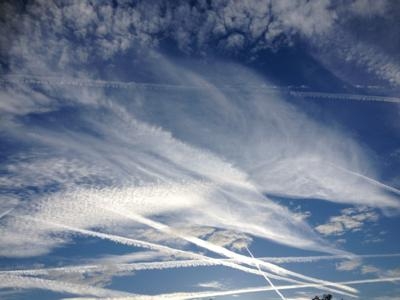Mon, Jun 27, 2016
New Study In The Journal 'Nature Communications' Focuses On Contrails
Clouds may have a net warming or cooling effect on climate, depending on their thickness and altitude. Artificially formed clouds called contrails form due to aircraft effluent, in a cloudless sky, contrails are thought to have minimal effect on climate. But what happens when the sky is already cloudy? In a new study published in the journal Nature Communications, scientists from the University of Hertfordshire and Stockholm University show that contrails that are formed within existing high clouds increase the reflectivity of these clouds, i.e. their ability to reflect light. The researchers hope that their discovery offers important insights into the influence of aviation on climate.

"Normal contrails are the stripes you sometimes see behind high-flying aircraft. Lots of times these contrails disappear fairly quickly. Other times they stick around for a while, and even spread out, sometimes considerably. There has been a lot of work done to find out how these form, and what kind of climatic effect they have - which is estimated to be rather small. Figuring out what kind of effects airplanes have while flying through clouds that are already present in the atmosphere has been much more difficult," says Kevin Noone, Professor at the Department of Environmental Science and Analytical Chemistry at Stockholm University.
"Though contrails and their effect on climate have been studied for quite a while now, we have not yet investigated what happens when they form in already existing clouds. This is partly because the imaging sensors conventionally used for this kind of research are not able to resolve what is going on inside the clouds. We were excited to see that overcoming this limitation would immediately lead to a new discovery," adds Matthias Tesche, Lecturer in Physics at the University of Hertfordshire.
The researchers used a combination of flight tracking data and satellites equipped with sensitive lasers for detecting small changes in cloud optical thickness, i.e. the degree to which a cloud prevents light passing through it. When they looked at flight corridors from Honolulu to Los Angeles, Seattle and San Francisco, they found a significant increase in the optical thickness of the clouds close to the flight tracks compared to those further away. In other words, clouds inside flight corridors were more reflective or "brighter."
"Such effects only occur in certain latitude bands, so aircraft flying on polar routes in the Northern Hemisphere and close to the Equator are unlikely to produce these sorts of clouds. The most important areas are in the Northern and Southern mid-latitudes. Work is in progress to calculate the climatic effects of the changes we've observed," says Professor Noone.
(Image provided with University of Hertfordshire news release)
More News
Aero Linx: International Federation of Airworthiness (IFA) We aim to be the most internationally respected independent authority on the subject of Airworthiness. IFA uniquely combi>[...]
Ultrahigh Frequency (UHF) The frequency band between 300 and 3,000 MHz. The bank of radio frequencies used for military air/ground voice communications. In some instances this may >[...]
A Few Questions AND Answers To Help You Get MORE Out of ANN! 1) I forgot my password. How do I find it? 1) Easy... click here and give us your e-mail address--we'll send it to you >[...]
From 2019 (YouTube Edition): Learning To Paint Without Getting Any On Your Hands PPG's Aerospace Coatings Academy is a tool designed to teach everything one needs to know about all>[...]
Also: Sustainable Aircraft Test Put Aside, More Falcon 9 Ops, Wyoming ANG Rescue, Oreo Cookie Into Orbit Joby Aviation has reason to celebrate, recently completing its first full t>[...]
 ANN's Daily Aero-Linx (05.06.25)
ANN's Daily Aero-Linx (05.06.25) ANN's Daily Aero-Term (05.06.25): Ultrahigh Frequency (UHF)
ANN's Daily Aero-Term (05.06.25): Ultrahigh Frequency (UHF) ANN FAQ: Q&A 101
ANN FAQ: Q&A 101 Classic Aero-TV: Virtual Reality Painting--PPG Leverages Technology for Training
Classic Aero-TV: Virtual Reality Painting--PPG Leverages Technology for Training Airborne 05.02.25: Joby Crewed Milestone, Diamond Club, Canadian Pilot Insurance
Airborne 05.02.25: Joby Crewed Milestone, Diamond Club, Canadian Pilot Insurance



